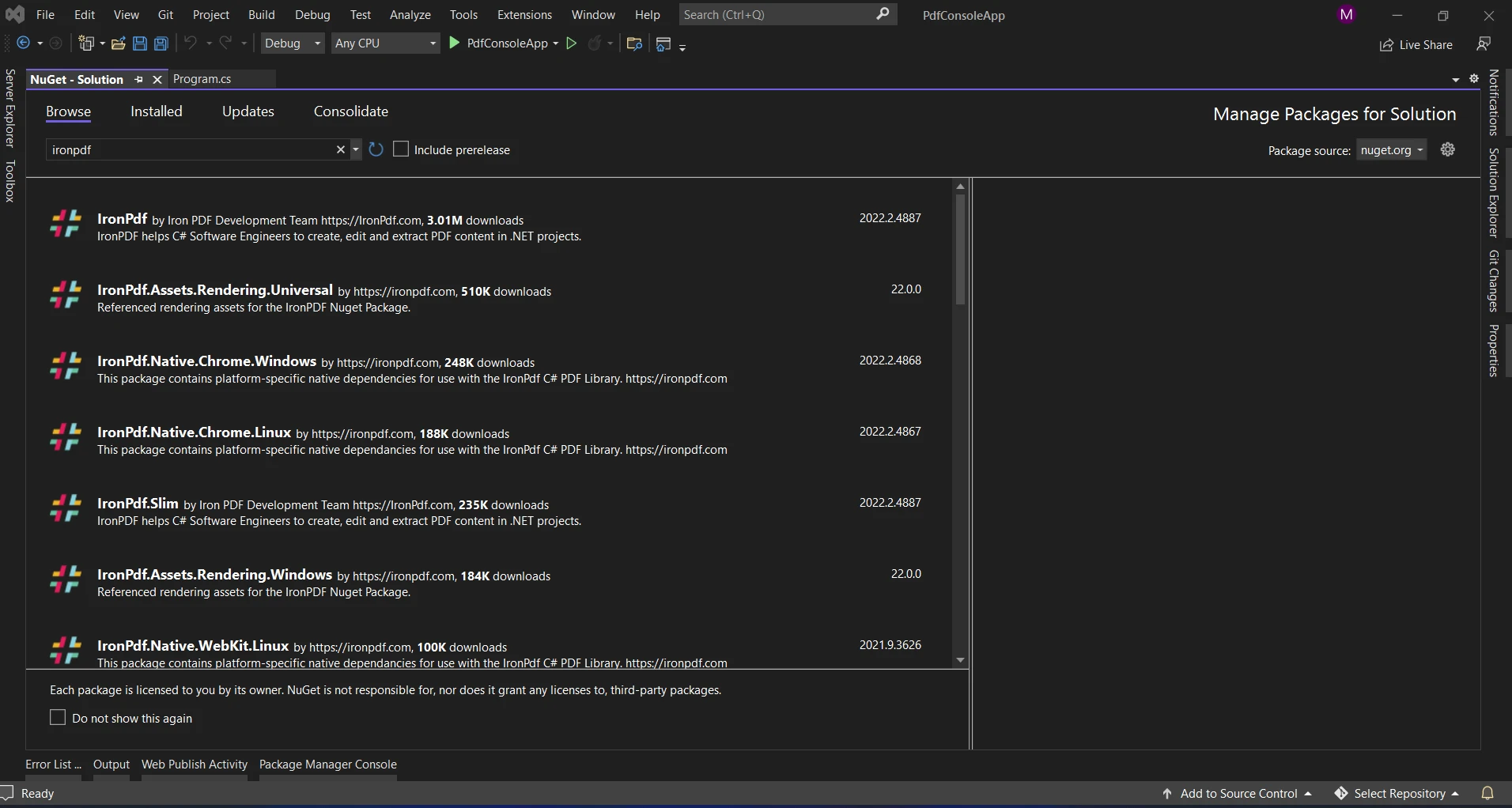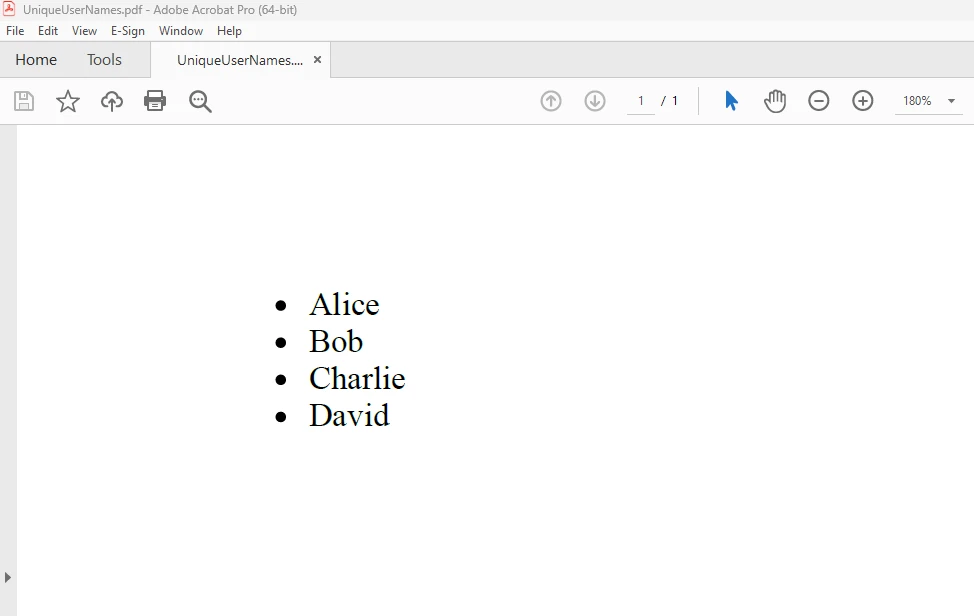Test in a live environment
Test in production without watermarks.
Works wherever you need it to.
Programming in C# is flexible and provides a large array of data structures to effectively manage various jobs. The HashSet is one such potent data structure that offers distinct components and constant-time average complexity for fundamental operations. This post will examine the use of HashSet in C# and how it may be used with IronPDF, a powerful library for working with PDF documents.
HashSet in C# is designed to provide high-performance set operations. A HashSet is the perfect collection to use in situations when you need to keep a distinct set of data since it prevents duplicate elements. It's included in the System.Assortments.Hash tables, the foundation of the C# generic namespace, and provides quick insertion, deletion, faster retrieval and lookup operations. We can also find the proper subset in the HashSet elements. In C#, use HashSet set operations methods that let you easily carry out standard set operations. The HashSet class provides set operations methods.
The following are a few C# uses for a HashSet:
Establishing a HashSet and carrying out fundamental actions such as appending, deleting, and verifying the existence of entries.
// set operations
HashSet<int> numbers = new HashSet<int>();
// Add elements
numbers.Add(1);
numbers.Add(2);
numbers.Add(3);
// Remove an element, predicate function
numbers.Remove(2);
// Check for membership or duplicate element
bool containsThree = numbers.Contains(3);// set operations
HashSet<int> numbers = new HashSet<int>();
// Add elements
numbers.Add(1);
numbers.Add(2);
numbers.Add(3);
// Remove an element, predicate function
numbers.Remove(2);
// Check for membership or duplicate element
bool containsThree = numbers.Contains(3);' set operations
Dim numbers As New HashSet(Of Integer)()
' Add elements
numbers.Add(1)
numbers.Add(2)
numbers.Add(3)
' Remove an element, predicate function
numbers.Remove(2)
' Check for membership or duplicate element
Dim containsThree As Boolean = numbers.Contains(3)Using an existing collection as the starting point for a HashSet, duplicates are immediately eliminated.
List<int> duplicateNumbers = new List<int> { 1, 2, 2, 3, 3, 4 }; // all the elements
HashSet<int> uniqueNumbers = new HashSet<int>(duplicateNumbers);List<int> duplicateNumbers = new List<int> { 1, 2, 2, 3, 3, 4 }; // all the elements
HashSet<int> uniqueNumbers = new HashSet<int>(duplicateNumbers);Dim duplicateNumbers As New List(Of Integer) From {1, 2, 2, 3, 3, 4} ' all the elements
Dim uniqueNumbers As New HashSet(Of Integer)(duplicateNumbers)Combining two HashSet instances to produce a new set that combines distinct items from both sets using the UnionWith function.
HashSet<int> set1 = new HashSet<int> { 1, 2, 3 };
HashSet<int> set2 = new HashSet<int> { 3, 4, 5 };
set1.UnionWith(set2); // set1 now contains { 1, 2, 3, 4, 5 }HashSet<int> set1 = new HashSet<int> { 1, 2, 3 };
HashSet<int> set2 = new HashSet<int> { 3, 4, 5 };
set1.UnionWith(set2); // set1 now contains { 1, 2, 3, 4, 5 }Dim set1 As New HashSet(Of Integer) From {1, 2, 3}
Dim set2 As New HashSet(Of Integer) From {3, 4, 5}
set1.UnionWith(set2) ' set1 now contains { 1, 2, 3, 4, 5 }Using the IntersectWith function, determine the shared components between two HashSet instances.
HashSet<int> set1 = new HashSet<int> { 1, 2, 3 };
HashSet<int> set2 = new HashSet<int> { 3, 4, 5 };
set1.IntersectWith(set2); // set1 now contains { 3 }HashSet<int> set1 = new HashSet<int> { 1, 2, 3 };
HashSet<int> set2 = new HashSet<int> { 3, 4, 5 };
set1.IntersectWith(set2); // set1 now contains { 3 }Dim set1 As New HashSet(Of Integer) From {1, 2, 3}
Dim set2 As New HashSet(Of Integer) From {3, 4, 5}
set1.IntersectWith(set2) ' set1 now contains { 3 }Using the ExceptWith function, find the elements that are in one HashSet but not in another.
HashSet<int> set1 = new HashSet<int> { 1, 2, 3 };
HashSet<int> set2 = new HashSet<int> { 3, 4, 5 };
set1.ExceptWith(set2); // set1 now contains { 1, 2 }HashSet<int> set1 = new HashSet<int> { 1, 2, 3 };
HashSet<int> set2 = new HashSet<int> { 3, 4, 5 };
set1.ExceptWith(set2); // set1 now contains { 1, 2 }Dim set1 As New HashSet(Of Integer) From {1, 2, 3}
Dim set2 As New HashSet(Of Integer) From {3, 4, 5}
set1.ExceptWith(set2) ' set1 now contains { 1, 2 }Checking for Subset or Superset:
Using the IsSubsetOf and IsSupersetOf methods, one may ascertain whether a given HashSet instance is a subset or superset of another.
HashSet<int> set1 = new HashSet<int> { 1, 2, 3 };
HashSet<int> set2 = new HashSet<int> { 2, 3 };
bool isSubset = set2.IsSubsetOf(set1); // returns true
bool isSuperset = set1.IsSupersetOf(set2); // returns trueHashSet<int> set1 = new HashSet<int> { 1, 2, 3 };
HashSet<int> set2 = new HashSet<int> { 2, 3 };
bool isSubset = set2.IsSubsetOf(set1); // returns true
bool isSuperset = set1.IsSupersetOf(set2); // returns trueDim set1 As New HashSet(Of Integer) From {1, 2, 3}
Dim set2 As New HashSet(Of Integer) From {2, 3}
Dim isSubset As Boolean = set2.IsSubsetOf(set1) ' returns true
Dim isSuperset As Boolean = set1.IsSupersetOf(set2) ' returns trueUsing the SymmetricExceptWith technique, determine the symmetric difference (elements present in one set, but not in both).
HashSet<int> set1 = new HashSet<int> { 1, 2, 3 };
HashSet<int> set2 = new HashSet<int> { 3, 4, 5 };
set1.SymmetricExceptWith(set2); // set1 now contains { 1, 2, 4, 5 }HashSet<int> set1 = new HashSet<int> { 1, 2, 3 };
HashSet<int> set2 = new HashSet<int> { 3, 4, 5 };
set1.SymmetricExceptWith(set2); // set1 now contains { 1, 2, 4, 5 }Dim set1 As New HashSet(Of Integer) From {1, 2, 3}
Dim set2 As New HashSet(Of Integer) From {3, 4, 5}
set1.SymmetricExceptWith(set2) ' set1 now contains { 1, 2, 4, 5 }Programmers may use the C# language to produce, edit, and modify PDF documents by utilizing the IronPDF .NET PDF library. The application offers a wide range of tools and features to enable different operations with PDF files, including creating new PDFs from HTML, converting HTML to PDF, combining or dividing PDF documents, and annotating existing PDFs with text, photos, and other data. To know more about the IronPDF, refer to this documentation.
Acquire the IronPDF library; the upcoming patch requires it. To do this, enter the following code into the Package Manager:
Install-Package IronPDF
//or
dotnet add package IronPdf
Another option is to look for the package "IronPDF" using the NuGet Package Manager. From all the NuGet packages related to IronPDF, we may select and download the required package from this list.

Within the C# environment, IronPDF is a powerful library that makes working with PDF documents easier. In situations where distinct data representation and effective document creation are crucial, combining the efficiency of HashSet with the document manipulation powers of IronPDF might result in creative solutions.
Now let's look at a real-world scenario where using HashSet with IronPDF might be useful.
using IronPdf;
using System;
using System.Collections.Generic;
using System.IO;
class PdfGenerator
{
static void Main()
{
// Sample user names
string [] userNames = { "Alice", "Bob", "Charlie", "Bob", "David", "Alice" };
// Using HashSet to store unique user names
HashSet<string> uniqueUserNames = new HashSet<string>(userNames);
// Generating PDF with unique user names
GeneratePdf(uniqueUserNames);
}
static void GeneratePdf(HashSet<string> uniqueUserNames)
{
// Create a new PDF document using IronPDF
IronPdf.HtmlToPdf renderer = new IronPdf.HtmlToPdf();
PdfDocument pdf = renderer.RenderHtmlAsPdf(BuildHtmlDocument(uniqueUserNames));
// Save the PDF to a file
string pdfFilePath = "UniqueUserNames.pdf";
pdf.SaveAs(pdfFilePath);
// Display a message with the file path
Console.WriteLine($"PDF generated successfully. File saved at: {pdfFilePath}");
}
static string BuildHtmlDocument(HashSet<string> uniqueUserNames)
{
// Build an HTML document with unique user names
string htmlDocument = "<html><body><ul>";
foreach (var userName in uniqueUserNames)
{
htmlDocument += $"<li>{userName}</li>";
}
htmlDocument += "</ul></body></html>";
return htmlDocument;
}
}using IronPdf;
using System;
using System.Collections.Generic;
using System.IO;
class PdfGenerator
{
static void Main()
{
// Sample user names
string [] userNames = { "Alice", "Bob", "Charlie", "Bob", "David", "Alice" };
// Using HashSet to store unique user names
HashSet<string> uniqueUserNames = new HashSet<string>(userNames);
// Generating PDF with unique user names
GeneratePdf(uniqueUserNames);
}
static void GeneratePdf(HashSet<string> uniqueUserNames)
{
// Create a new PDF document using IronPDF
IronPdf.HtmlToPdf renderer = new IronPdf.HtmlToPdf();
PdfDocument pdf = renderer.RenderHtmlAsPdf(BuildHtmlDocument(uniqueUserNames));
// Save the PDF to a file
string pdfFilePath = "UniqueUserNames.pdf";
pdf.SaveAs(pdfFilePath);
// Display a message with the file path
Console.WriteLine($"PDF generated successfully. File saved at: {pdfFilePath}");
}
static string BuildHtmlDocument(HashSet<string> uniqueUserNames)
{
// Build an HTML document with unique user names
string htmlDocument = "<html><body><ul>";
foreach (var userName in uniqueUserNames)
{
htmlDocument += $"<li>{userName}</li>";
}
htmlDocument += "</ul></body></html>";
return htmlDocument;
}
}Imports IronPdf
Imports System
Imports System.Collections.Generic
Imports System.IO
Friend Class PdfGenerator
Shared Sub Main()
' Sample user names
Dim userNames() As String = { "Alice", "Bob", "Charlie", "Bob", "David", "Alice" }
' Using HashSet to store unique user names
Dim uniqueUserNames As New HashSet(Of String)(userNames)
' Generating PDF with unique user names
GeneratePdf(uniqueUserNames)
End Sub
Private Shared Sub GeneratePdf(ByVal uniqueUserNames As HashSet(Of String))
' Create a new PDF document using IronPDF
Dim renderer As New IronPdf.HtmlToPdf()
Dim pdf As PdfDocument = renderer.RenderHtmlAsPdf(BuildHtmlDocument(uniqueUserNames))
' Save the PDF to a file
Dim pdfFilePath As String = "UniqueUserNames.pdf"
pdf.SaveAs(pdfFilePath)
' Display a message with the file path
Console.WriteLine($"PDF generated successfully. File saved at: {pdfFilePath}")
End Sub
Private Shared Function BuildHtmlDocument(ByVal uniqueUserNames As HashSet(Of String)) As String
' Build an HTML document with unique user names
Dim htmlDocument As String = "<html><body><ul>"
For Each userName In uniqueUserNames
htmlDocument &= $"<li>{userName}</li>"
Next userName
htmlDocument &= "</ul></body></html>"
Return htmlDocument
End Function
End ClassIn the above code example, we save unique user names retrieved from an array using a HashSet uniqueUserNames. The HashSet automatically eliminates duplicates. Next, we create an unordered list of these distinct user names in a PDF document using IronPDF. To know more about the code check here.

To sum up, the C# HashSet data structure is an effective tool for organizing sets of distinct items. It creates new opportunities for dynamic, one-of-a-kind, and performance-optimized PDF document creation when paired with IronPDF.
We illustrated how to use HashSet to guarantee data uniqueness while using IronPDF to create PDF documents in the example that was given. Building strong and effective C# applications may benefit from the combination of HashSet and IronPDF, whether you're working on data deduplication, reporting, or managing dynamic content. As you investigate more, take into account the many contexts in which you might utilize this combination to improve the usability and functionality of your apps.
The $749 Lite version of IronPDF comes with a permanent license, upgrade options, and a year of software support. Throughout the watermarked trial period to find out more about IronPDF's price, licensing, and free trial. Visit this page for further information on Iron Software.
9 .NET API products for your office documents








